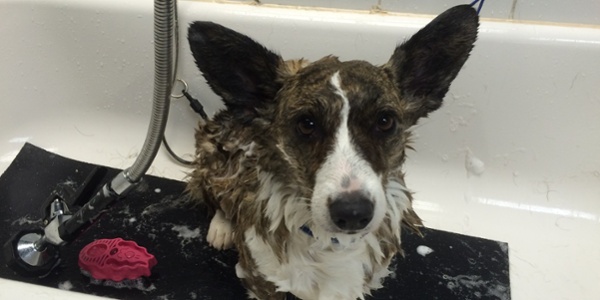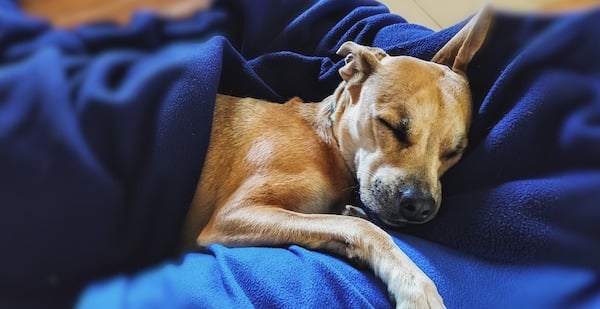- en
Pet InfoRx®
Dog Ear Infections
Your dog has an ear infection! Now what?
This pet information prescription will help you know what to do, how to make your dog more comfortable, and how to prevent this from happening in the future.
Quick Links
Why Dogs Shake

Why does your dog do a full-body shake every once in a while? Is it normal? Yup, it is. When a dog does its "shake," it's a sort of "re-boot" or reset — to start fresh. Perhaps their fur is out of place, they're wet, or something has caused them stress, and they're re-setting and moving on. If your dog frequently shakes, though, it could be a medical problem, like an ear infection, so consult a veterinarian.
Our mission is to help save dogs' and cats’ lives through our educational content. To support our efforts, this page may contain affiliate links. We earn a commission for qualifying purchases – at no cost to you.
What Are Ear Infections?
The most common type of ear infection in dogs is known as otitis externa. It is the inflammation and infection of the external ear canal’s lining. Otitis externa can be a primary or secondary disease process. Its causes can be multifactorial, making it difficult to make a diagnosis and treatment at times. The pinna (ear flap) and inside the ear may be red, swollen, and there could be a foul smell. Some people think it smells like corn chips – this is the smell of the yeast overgrowth. The ear canal can have either a dark brown or yellow discharge. On occasion, they are a result of an ear mite infestation.
How Did This Happen?
Your dog could've gotten an ear infection:
- from swimming or bathing, if their ears weren't dried properly afterward (this must be done with a proper ear cleaner that contains a cleaning and drying agent)
- because a dog’s ear canal is a right angle shaped like an “L” – once moisture gets down there, it has nowhere to go. This becomes the perfect breeding ground for yeast and bacteria.
- because sometimes allergies to foods and the environment cause issues with ears
- from excessive hair in the ear canals because it can trap moisture
- from cleaning too much or using Q-tips to clean the ears
- because of breed predispositions, i.e., some get ear infections more (e.g., cocker spaniels and beagles)
- from obstructive diseases like polyps, hyperplasia (thickening of the tissue)
How Does This Affect You and Your Family?
 Because your dog may be painful, there is an increased risk of them biting or nipping as a defense mechanism, particularly if their ears are touched. Be sure that any children in the home are aware that your dog may be more sensitive around their head and ears, and don’t leave them together unsupervised.
Because your dog may be painful, there is an increased risk of them biting or nipping as a defense mechanism, particularly if their ears are touched. Be sure that any children in the home are aware that your dog may be more sensitive around their head and ears, and don’t leave them together unsupervised.
Be aware of your dog’s possible discomfort when cleaning or treating their ear infection. If you aren’t able to do so safely, stop and talk to your veterinarian about the next steps.
Untreated ear infections may eventually lead to hearing loss, changing the way you and your family communicate with your pet.
What You Should Do If Your Dog Has An Ear Infection
Follow your veterinarian’s instructions to medicate and/or clean your dog's ears. Only do the things in the list below if your veterinarian instructed you to since different infections require different types of cleaning or no cleaning at all.
Based on the type of ear infection and the medications prescribed, your dog may need:
- medicated ear drops administered daily
- a medicated ear “pack” that dissolves and treats over 1–2 weeks
- oral antibiotics, antifungals, or anti-inflammatories
- regular ear cleanings (see the steps below)
- diet changes (your veterinarian will recommend what to change in your dog's diet)
- hair removed from the ear canal
- a recheck examination to ensure the infection has resolved

How to Clean Your Dog's Ears (these steps work for cats too!)
Tools you will need:
- a safe and effective ear cleaner – they're not all created equal, so ask a veterinarian for a recommendation
- some gauze pads (3x3 inches in size), cotton balls, or make-up removal rounds, even tissues will work
- a towel
- dog treats to reward your pup with
If your pet is feeling a lot of pain, it may be wise to muzzle your dog to protect yourself from a bite.
Steps to clean your pet's ears
- Wrap your pet in a towel to help keep them dry and calm them. This also helps prevent you from getting scratched with their front paws.
- Hold your pet’s ear flap up to open it.
- Shake the ear cleaner bottle well before use. Then gently place the tip of the bottle over the opening of your pet’s ear canal but do not touch the ear if possible. If the tip touches tender skin, it may hurt, and if your pet jumps and the tip is on the ear, it may jab the ear. (Be kind to your pet as the solution can be cold – make sure it's room temperature or, better still, gently warm the cleaner slightly by putting the bottle under warm running water for a few minutes).
- Gently squeeze a lot of the cleaner into your pet’s ear until the liquid runs out of the ear canal opening. You need an adequate amount of cleaner to get deep into the canal to clean it properly.
- Keeping the ear flap held up, vigorously massage the base of your pet’s ear (do this for a good 10–15 seconds). If your pet's ears are too infected, or if they really don't like having the cleaner squirted directly into their ears, you can heavily soak a cotton ball with the cleaner, place it onto the top of the ear canal and then massage it to release the cleaner. This isn’t the most ideal way to clean ears because it is hard to get enough cleaner deep into the canal for flushing.
- Keeping the ear flap held up, grab whatever soft, absorbent material you're using, wrap it around the tip of your finger, and then gently stick that finger into your pet’s ear canal (do not force your finger in). In a non-scrubbing manner, wipe up and out as much of the liquid and ear debris as you can. "Ear debris" is the brownish gunk that you'll notice on the cotton ball. In some cases, it can be a yellowish discharge. A healthy, clean ear won't have this dark brown or yellowish stuff coming out of it.
- Repeat the flushing and wiping step above as many times as is necessary to get the bulk of the ear debris out. Generally, you will need to clean the ears every other day (depending on the type of medication given).
- Stand back – your pet will want to shake their head.
- The towel can now be used to dry your pet and yourself off!
- Reward your pup with some yummy treats!
Making the activity of cleaning your pet's ears enjoyable is an excellent goal to have. Because once their ear infection is cleared up, you'll want to do regular ear maintenance – cleaning once a week if possible.
ALWAYS clean your pet’s ears after a bath or swimming and when they return from the groomers. This type of cleaning isn’t as involved as when an ear infection is present. If you are using an ear cleaner with a cleaning and drying agent, such as Otiderm®, for post bathing/swimming times, just overfill the ear canal with cleaner and massage. BOOM! You are done!
Keep Your Dog Comfortable
The best thing you can do is use the medication your veterinarian prescribed and follow their directions for cleaning (but only if they have recommended this).
Make sure to use the medication for the entire length of time prescribed, even if your dog feels better in a day or two. This is important to make sure the infection is fully treated — and doesn’t come back! Avoid touching or rubbing their ears (except for cleaning) until their infection goes away since this may be uncomfortable for them.
It is highly recommended that you have your pet rechecked just before finishing medications to be sure the infection is cleared.
How Do You Know Things Are Improving?
You should notice a decrease in your dog scratching and shaking their head. Your pet’s ear should look less red, and the odor should be getting better.
If you're cleaning their ears, the stuff coming out should eventually be a clear or light brown color.
How Do You Know When Things Are Not Improving? What You Should Do.
If your pet is still uncomfortable with no decrease in scratching or shaking after 3–5 days of treatment, you should call your veterinarian and let them know. After a week, if you're still seeing dark brown debris on the gauze pad when you’re cleaning their ears, this also means that the infection is likely still present. If your pet suddenly develops a head tilt to one side or the other, stop all cleaning and medication and get them to a veterinarian right away.

How to Prevent This from Happening in the Future
Ear infections often happen after a bath or swimming, when water gets trapped in a dog’s L-shaped ear canal. Try to avoid getting water in their ears during a bath. Don't pour water over their head or use the shower nozzle – use a wet face cloth or sponge instead. It's also helpful to put a piece of cotton ball in their ears before a bath, but make sure to remove it right after!

If you think water got in during a bath, or when your dog goes for a swim, be sure to use an ear cleaner with a drying lotion to make sure any moisture that got into their ear canals will disappear. A veterinarian can recommend the proper ear cleaner to use.
If your pet has long hair on the inside of their ears, it can sometimes help to flip their ear flaps back to allow for some air circulation. It often will help to keep the inside flap and area below the base of the ear canal trimmed short. For those pups with hair inside their canals who have had repeat ear infections, having the groomer pluck their ear hair may help, but this is only recommended for pets with a history of ear problems.
The Pet InfoRx® is made possible, in part, through our partnership with AlignCare®.


© Preventive Vet. All rights reserved. PreventiveVet.com


